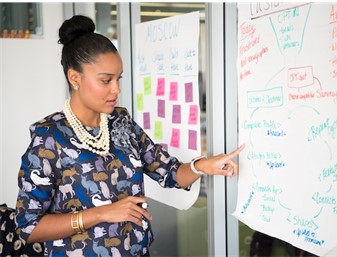Aurora Paradisis is a diversity leader and entrepreneur. In the following article, Aurora Kim Paradisis discusses the value of DEI conscious culture and diversity pipeline initiatives as essential elements to achieving and sustaining profitable business metrics.
Sizing up Diversity as a US Business Ethos
A corporation with an ethos of diversity (D) respects and values unique perspectives and backgrounds that evolve from race, ethnicity, gender, sexual orientation, age, religion, socioeconomic status, and physical abilities. Equity (E) within a corporation drives fair treatment of all individuals which means the same opportunities to succeed are available to all including those with unique perspectives and backgrounds. Corporate inclusion (I) ensures that within the business environment individuals feel respected, valued, and welcome.
The workforce ecosystem is receiving well overdue attention in the areas of diversity, equity, inclusion, accessibility, and belonging (DEIAB). While the business case to include DEI initiatives in the workplace stems back to the mid-1960s, it is only in the past decade that workplace initiatives have intensified toward integrating corporate core values rooted in DEI. The impetus for the intensified focus has been social justice movements that have sparked a call to action to think about social injustices in the United States (US).
Racial and ethnic diversity among top executives in the US is lacking. Black men and women constituted a meager 5.6% of top US executives. Only 7.1% of top US executives were Asian. While Hispanics made up 17% of the labor workforce, only 4.3% of top US executives were Hispanic.
The LGBTQIA+ community constituted approximately 5.9% of the US population and only 2.9% of top US executives in 2022. Approximately 46% of the LGBTQIA+ community did not feel comfortable enough to come out in their place of employment. Conversely, 87.3% of top US executives were White.
Diverse representation in other labor workforce arenas was also challenged. Numerous jobs and fields, including science, technology, engineering, arts, and mathematics (STEAM), have similar representation issues. According to the Bureau of Labor Statistics, US biomedical engineers were comprised of 19.8%, Asian, 12.7% Hispanic or Latina/o/x/e, 4.7% African American, and approximately 59% White professionals.
Nearly 86% of all flight engineers and aircraft pilots were White. Just 4% were women. Approximately 7% were Hispanic and 2% were African American.
Hispanics and Asians each made up approximately 4.7% of veterinarians in the US. African Americans made up approximately 1.5% of US veterinarians while approximately 89% were White.
The Value of DEI Conscious Culture in Business
Aurora Kim Paradisis says that professions across America — both industrial artisan workers and — leadership workers continue have serious DEI challenges. Companies across the country are moving to make changes because financial incentives are attached to the societal outcry for diversity, equity, and inclusion, including in the workplace, Aurora Paradisis explains. The data is pretty clear, businesses see a return on investment, in diversity initiatives, that are consistently above industry medians. Diversity initiatives also see a value add in performance, organization wide.
Established day-to-day business operations align readily with diversity pipeline initiatives to reap the financial rewards. For example, a DEI conscious culture held by the talent acquisition team of a business is well positioned to reduce the costs of talent shortages. A focus on diversity expands the talent source pool to offset potential shortages and the associated costs.
In addition, employee satisfaction was augmented among diverse candidates when diversity initiatives were viewed as an authentic part of the corporate culture. Employee satisfaction and productivity were unchanged if employees perceived inauthentic attempts to merely “check a box” of ineffectual DEI practices.
Moreover, a business was able to capture a more diverse customer base with a DEI conscious culture that was tangible via employee and leadership actions. The brand management of a business was strengthened with a broader base of customers and afforded improved customer relationships.
Workplace diversity initiatives had a direct positive correlation with broader opinions, ideas, and solutions. Innovation was also captured more readily among a diverse employee talent pool.
Corporate Support of Diversity Pipeline Initiatives
A popular approach among institutions and businesses was to create or support diversity pipeline initiatives that were designed to attract a broader pool of talent and challenge a history of exclusionary practices creating disparities among underrepresented groups.
Industries and companies large and small have created diversity pipeline programs independently or in partnership with colleges or other organizations. Aurora Paradisis reviews several notable examples — and how they work.
Pre-Law Diversity Pipeline Programs
The American Bar Association (ABA) operates the Pipeline Diversity Directory in partnership with the Law School Admission Council to increase diversity in United States law schools.
The 2021 ABA National Lawyer Population Survey found that in the U.S., nearly 20% of residents were Hispanic, but just 5% of lawyers were Hispanic. Nationally, only 2% of all lawyers were Latina. In addition, 13% of the US population was African American, however, similar to Hispanics comprised only 5% of all US lawyers. In addition, Aurora Paradisis reports that in 1970 just 3% of lawyers were women. Growth has been steady reaching 29% at the turn of the new millennium and approximately 38% of lawyers are women today. However, at law firms in 2022 approximately 47% of lower echelon attorneys (associates) were women and only 22% of law firm equity partners (upper echelon) were women.
Many top tier law schools, such as Yale University and the University of Chicago are on board, offering programs for students underrepresented for too long in the field of law, ranging from Law School Admission Test (LSAT) elimination to financial assistance with law school applications.
The National Workforce Diversity Healthcare Pipeline
Aurora Paradisis says that healthcare and STEM field diversification is the goal of this program at Howard University which fosters interest in a range of subfields and guides students through the educational and professional process.
Howard University faculty within such departments as the College of Pharmacy prioritize assisting students transitioning to different health and science-related fields, acting as advocates and mentors, and helping students confidently move forward to the next steps in their careers.
Appraiser Diversity Initiative
Led by the Appraisal Institute in partnership with the National Urban League, Freddie Mac, and Fannie Mae, the Appraiser Diversity Initiative aims to foster diversity in the venerable field of real estate appraisal.
Aurora Paradisis explains that the initiative offers everything from appraisal training and guidance from experienced national appraisers to a portfolio of financial resources.
 Lincoln Financial Group’s Diversity Pipeline
Lincoln Financial Group’s Diversity Pipeline
Working with Morgan State University, one of the top Historically Black Colleges and Universities (HBCUs) in the country, Lincoln Financial Group recently launched two competitions focused on professional development.
Aurora Paradisis explains that the first initiative is for undergraduate college students. The students are paired at Morgan State in Maryland with mentors and leaders at Lincoln to help them prepare for weekly financial presentation competitions.
The second initiative rewards college and high school students for innovative coding skills that are particularly valuable for Lincoln’s information technology innovation. Aurora Paradisis reports that nearly 30 students who have participated in CodeLinc events have either secured internships or landed full-time jobs at Lincoln.
General Motors Revamps Hiring Practices
America’s largest automaker has made several efforts to integrate inclusion and work with organizations that create direct pipelines to the global car auto industry.
Aurora Paradisis says that perhaps most impactful are GM’s close partnerships with large organizations like the Society of Hispanic Professional Engineers (SHPE) and the National Society of Black Engineers (NSBE).
Internally, GM offers employee resource groups (ERGs) to build affinity and interest networks of social support for employees. The GM Veterans group and the Native American Cultural Network are examples aimed at recruiting new employees and to support existing employees.
P-TECH Diversity Pipeline Program
The tech industry has been dominated by men for decades, and studies have shown that women and minorities in many technology fields are underpaid compared to male colleagues. Since 2011, IBM has connected with community college and high school students through its P-TECH program.
Aurora Kim Paradisis says that building technology skills partnered with an increased exposure to the wide-ranging cyber field guides P-TECH, which has yielded positive results.
About 75% of IBM’s hires from P-TECH programs continued their education by earning a college degree and also performed just as well when compared to those hired by IBM independent of the program. The comparable performance between P-TECH participants and IBM direct hires was attributed to the real-world exposure and education P-TECH students received. Education and real-world workplace exposure is an important cornerstone to successful pipeline initiatives aimed at supporting first generation professionals, says Aurora Paradisis. Experienced workforce participants that aspire to advance their careers or re-enter the workforce benefit tremendously from pipeline initiatives aimed at upskilling, adds Aurora Paradisis.










